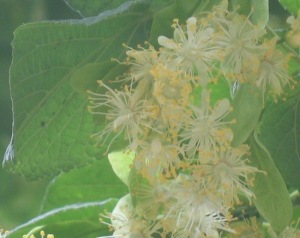 My very favourite period of summer in London is just about to begin……when the lime trees (linden) come into flower and the perfume wafts down the street – you can see the bees going literally crazy, getting tipsy in a massive honey fest. Different trees come into bloom over a period of 2 or 3 weeks, mainly depending on how much sun they get, but there are different varieties. Some of the later flowering trees seem to have a muskier perfume, which I’ve never used for this syrup.
My very favourite period of summer in London is just about to begin……when the lime trees (linden) come into flower and the perfume wafts down the street – you can see the bees going literally crazy, getting tipsy in a massive honey fest. Different trees come into bloom over a period of 2 or 3 weeks, mainly depending on how much sun they get, but there are different varieties. Some of the later flowering trees seem to have a muskier perfume, which I’ve never used for this syrup.
Continental Europeans have being using the flowers for tisanes and syrups for eons but it’s not quite so commonly used in the UK, so I originally got this recipe from
http://cuisinesauvage.blogspot.co.uk/2007/06/sirop-de-tilleul.html
(which is a really good site for forage recipes – it’s in French, but the recipes are so simply written that even a web translation usually comes out reasonably understandable, if you’re not fluent) – over the past couple of years, I have changed the quantities a bit ( less water, more flowers), but I’ve used the same process, which is the same as I use for elderflower cordial. As ever, you want freshly picked, newly opened blossoms – if you live somewhere with lots of trees, there’s less need to be quite so responsible about foraging, because there are so many blossoms and mature trees are so, so big and tall, you’ll spend half your time finding a tree with low hanging flowers 🙂 As far as I know, there aren’t any of our fellow creatures that depend on the seeds for food.
Ingredients – for every litre of water
250-300 grams of limeflower clusters – this translates as half a carrier bag, loosely packed, when you’re out collecting
500g sugar
5-10 grams of citric acid
Method
Lime flowers grow in clusters on a stalk with a pale green, paddle shaped bract. Remove the stalk and bract and put the flowers into a bowl big enough to take the amount of water you’re using. Boil the water, pour over the blossoms, cover with a teatowel and leave to infuse overnight or for at least 8 hours.
Strain through a sieve lined with muslin. Leave this to do it by itself, don’t try and squeeze the cloth to hurry it up.
Bring the infusion to a simmer with the sugar and 5g of the citric acid until the sugar has dissolved, then boil for 5 minutes. Taste and add more citric acid if desired. It keeps fine for a month in the fridge – I freeze mine in small containers – but if you’re going to bottle it to keep, use the hot water bath method and definitely use 10g of citric acid per litre of water.
The syrup has a flavour that most reminds me of honeyed pears, and it’s lovely as a drink, made into a sorbet or poured over icecream.
I also make a version which includes a sprig or two of lavender at the boiling stage, which was inspired by the ‘tranquility’ chocolate by the Belgian chocolatiers Newhouse.
London gets totally transformed in summer, at least on the side streets and in the parks, when it seems like the whole world has burst into bloom with cascades of sweetly scented roses, jasmine, lavender and honeysuckle.
On some roads, even the litter on the streets gets partially hidden by fallen petals, their colours sundried and scattered like the confetti of a thousand fairy weddings. I LOVE my city 🙂
